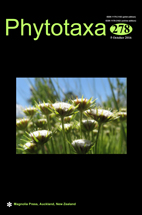Abstract
Cercosporoid fungi include a large number of mostly plant pathogenic fungi with a wide geographic distribution, being usually associated with leaf spots on a broad range of plant hosts. Here we initiate a series of studies on Chinese cercosporoid fungi, focussing on the identification of some common, rare and new plant diseases caused by these leaf-spotting ascomycetes. The aim of the series is to resolve the taxonomy and DNA phylogeny of this important group of phytopathogens in China. In this study, nine isolates of cercosporoid fungi were collected from five host species. Partial nucleotide sequence data of four gene loci (ITS, LSU, TUB and tef1-α rDNA) were generated for all isolates. Based on morphological characters in vivo and in vitro and phylogenetic data, a new species, Pseudocercospora pauciseptata (on living leaves of Pyracantha fortuneana), is introduced including a detailed description, illustration and comparison with similar species. In addition, Passalora circumscissa, Pseudocercospora cercidis-chinensis, P. lindericola, and P. prunicola are described, illustrated and phylogenetically characterized. Cerasus pseudocerasus represents a new host record for Passalora circumscissa in China, while Lindera reflexa is a new host for P. lindericola.

